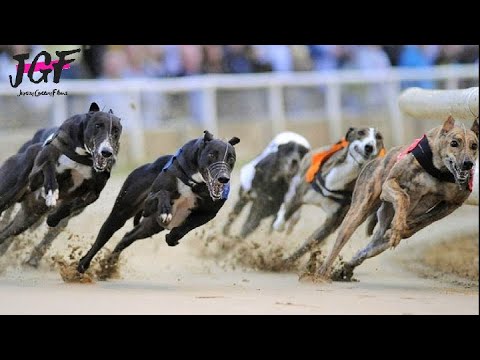The sport of greyhound racing, particularly over distances like 480 metres, is a fascinating blend of speed, strategy, athleticism and racing instincts. In this video titled Greyhound dog racing ‑ Track race 480m, viewers are given the opportunity to witness a full dash around the oval track — with all the power, the turn‐radius dynamics, the break from the traps, and the finish line sprint. YouTube+2YouTube+2
Setting the scene
The 480 m distance is a common and challenging trip in greyhound racing. It demands that the dogs not only break well, but maintain momentum, navigate the bends cleanly, and then have enough finish to stick it out in the home straight. For example, at 2008 English Greyhound Derby (which was run over 480 m) the winner clocked ~28.60 seconds, highlighting just how fast and intense these trips are. Wikipedia
From the video you’ll see how the dogs surge from the traps, hit the bend, settle into stride, and then go full tilt to the line. Because the track roll, the sand or surface, the banking and the angle of the turn all affect how the dog runs, you’ll see each moment matter.
What to watch for
Here are key elements to observe in the video:
- Break from the traps: The start is critical. A poor break can cost a dog time and momentum. Right out of the box you’ll observe how each greyhound negotiates the immediate bend and whether they get boxed in, forced wide, or find the rail.
- Bend and turn dynamics: Since the dogs are already near full speed entering the first bend, how they handle the curve is crucial. You’ll see some lean in, some drift out, some maintain the inside line. Good positioning through the bend often correlates with better finish.
- Mid‑race stride and sustaining speed: After the initial sprint and bend comes a phase where the dogs must hold their speed, settle their stride, and prepare for the closing run. Watch how some dogs change gear (or fail to) in this section.
- Final straight / finish line fight: In the last 100‑150 metres (depending on track layout) the race often goes from speed to strength. Some dogs will begin to bite at the rail, others will be coming wide. The finish will show stamina, closing speed, and how the dog deals with fatigue or traffic.
- Surface & outside effects: Notice whether the dogs on the outside lose ground on the bend, or whether the inside has an advantage. Surface kickback, sand give, or track condition (wet/dry) all play unseen roles.
Why this race matters
Greyhound racing may appear simple at first glance — dogs chasing a lure around a track — but the more you watch, the more layers you appreciate. For this video:
- It showcases raw speed in a relatively short trip – the 480 m dash allows minimal error, and split‑seconds make the difference.
- It highlights positioning and race tactics – even in greyhound racing, early positioning (trap draw, inside vs outside, bend handling) is very meaningful.
- It offers a window into athleticism – the greyhounds are trained athletes, responding to the lure, the track, their start, their drive. Articles on greyhound trainers describe how these dogs are built up in stages from sprint to standard distances. The Guardian
- For racing fans, the video provides reference material – you can compare break times, bend performance, final run‑downs. It helps build understanding of what makes a winning greyhound and what hurdles exist.

Potential talking points & narrative
If you are using this video on a channel or sharing it, you could frame it with some of the following ideas:
- “Here’s how a top‑class 480m greyhound race unfolds: note the break, the bend, and the final push.”
- “See how trap draw matters: inside dogs vs outside dogs, and how that affects the outcome.”
- “Observe how a greyhound’s stride changes through the race: early high speed, mid‑race momentum, final sprint.”
- “Consider track condition: if the surface is heavy or there’s moisture, you’ll see slower times or dogs losing ground on bends.”
Additional insight & context
From greyhound racing results (for example on the Greyhound Board of Great Britain site) we know the 480 m distance is used widely and results are tracked meticulously. gbgb.org.uk
Also, historical races over 480 m (like the English Greyhound Derby) are often used as benchmarks, so viewers can relate times or performance in this video to those more prestigious events. These comparisons enrich the viewing experience.
Why it’s a great video for your channel/viewers
- Accessibility: Whether someone is new to greyhound racing or a seasoned fan, the video gives a complete race at a standard distance – very watchable and educational.
- Speed & excitement: The short distance makes for a fast, compelling watch. There’s less “waiting around” and more full‑throttle racing.
- Teaching opportunity: You can use it to discuss racing mechanics – break, bend, finish – and how they apply across other racing sports too (horses, motorcycles, cars).
- Broader interest: Even outside pure racing fans, people enjoy watching animals (especially racing greyhounds) in action because of the visual speed, flow, and competition.
Final thoughts
In summary, this video – Greyhound dog racing ‑ Track race 480m – offers a dynamic, high‑intensity look at what makes greyhound racing compelling. From the moment the traps open to the dash down the straight, every second counts. Whether you’re watching for fun, for analysis, or for education, there’s something here: the athleticism of the dogs, the strategy of a good trap draw and bend handling, and the finishing fight that determines the winner.
If you’re curating content for a YouTube channel, race commentary blog, or simply want to build context around animal racing sports, this video works well. You might discuss the factors that influence performance (track surface, draw, distance, training) and invite viewers to comment on what they spotted.


